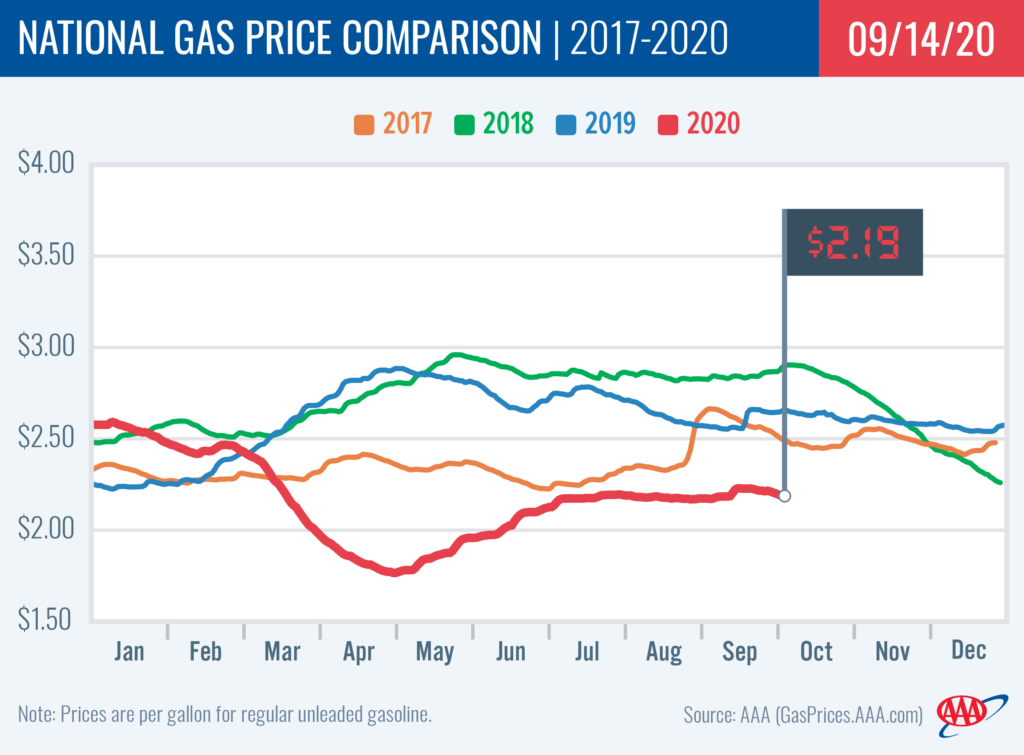
Gasoline demand has dropped to its lowest level since June, per a AAA analysis of the latest Energy Information Administration (EIA) report that found total demand measures 8.3 million barrels per day. As demand dropped for a second week, so too did gasoline supply levels – down nearly 3 million barrels to 231 million barrels. Still, supplies sit at a 3 million barrel year-over-year surplus as a result of the global COVID-19 pandemic.
“In a typical year, lower supply levels translate into higher pump prices. Despite consistent declines in gasoline stocks, though, that’s just not happening right now,” said Skyler McKinley, director of public affairs for AAA Colorado. “Even amid a steady supply dip, the sustained decrease in demand helped push national gas prices cheaper on the week.”
Today’s national gas price average sits at $2.19, down three cents from last week, two cents from a month ago, and 37 cents cheaper than this time last year. On the week, every single state saw gas prices decrease or stabilize at the pump. Colorado’s statewide average for a gallon of regular unleaded is $2.33, down from $2.35 a week ago, $2.40 a month ago, and $2.60 a year ago.
Gasoline Blend Switchover
Mid-September usually ushers in cheaper gas prices, as gas stations switch from summer-blend gasoline to winter-blend, which costs less to produce. The difference between the two blends comes down to Reid Vapor Pressure (RVP), which is a measure of how easily the fuel evaporates at a given temperature. The higher – or more volatile – the RVP, the more able it is to evaporate at low temperatures. Winter-blend has a higher RVP, which allows the fuel to evaporate at low temperatures for the engine to operate properly, especially when engines are cold. If the RVP is too low on a frigid day, the vehicle will be hard to start and, once started, will run rough.
“Motorists will see some savings at the pump as we switch to winter-blend, but the price difference will be smaller than is typical, given how cheap prices have been this year already,” McKinley said. “It’s also worth monitoring the hurricane outlook, which can meaningfully change any forecast for savings, region by region.”
Hurricane Outlook
The National Hurricane Center is currently tracking a number of tropical storms and depressions. Hurricane Sally, upgraded earlier today from Tropical Storm status, is expected to produce life-threatening storm surge and intense winds as it continues to strengthen near the northern Gulf Coast. Sally has already forced at least one refinery shutdown in Louisiana, at Phillips 66. Others are monitoring the storm to determine their next operational decisions. Most pump price impacts will be contained to the affected region, however, and a national impact is unlikely.
Oil Market Dynamics
At the close of Friday’s formal trading session, WTI increased by three cents to settle at $37.33, marking a weekly loss of $2.44. Domestic crude prices decreased after EIA’s weekly report revealed that total domestic crude inventories increased by 2 million barrels, increasing total stocks to 500.4 million barrels. Increasing stocks could signal that crude demand is in decline. Production, meanwhile, increased by 300,000 barrels per day last week to 10 million barrels per day. Crude prices will likely decrease further amid growing demand concerns.
Hurricane Sally has led some offshore platforms in the Gulf Coast to shutter production. Chevron shut and evacuated its Blind Faith and Petronius platforms, while Royal Dutch Shell said it may begin closing some of its offshore drilling operations on Sunday. Murphy Oil shut the Delta House platform because it is in the path of the storm.
The exact impact of the storm the storm and the length of operational shutdowns will determine if regional crude supply will be impacted, though the national impact should be negligible.
Colorado Gas By the Numbers
Denver
- Current Average: $2.27
- Yesterday Average: $2.27
- Week Ago Average: $2.30
- Month Ago Average: $2.36
- Year Ago Average: $2.52
Grand Junction
- Current Average: $2.30
- Yesterday Average: $2.30
- Week Ago Average: $2.32
- Month Ago Average: $2.36
- Year Ago Average: $2.64
Boulder-Longmont
- Current Average: $2.30
- Yesterday Average: $2.30
- Week Ago Average: $2.32
- Month Ago Average: $2.38
- Year Ago Average: $2.51
Greeley
- Current Average: $2.30
- Yesterday Average: $2.30
- Week Ago Average: $2.34
- Month Ago Average: $2.38
- Year Ago Average: $2.58
Colorado Springs
- Current Average: $2.32
- Yesterday Average: $2.32
- Week Ago Average: $2.34
- Month Ago Average: $2.38
- Year Ago Average: $2.53
Fort Collins-Loveland
- Current Average: $2.34
- Yesterday Average: $2.34
- Week Ago Average: $2.36
- Month Ago Average: $2.38
- Year Ago Average: $2.58
Pueblo
- Current Average: $2.36
- Yesterday Average: $2.36
- Week Ago Average: $2.40
- Month Ago Average: $2.49
- Year Ago Average: $2.73
Glenwood Springs
- Current Average: $2.59
- Yesterday Average: $2.60
- Week Ago Average: $2.58
- Month Ago Average: $2.59
- Year Ago Average: $2.99
Vail
- Current Average: $2.78
- Yesterday Average: $2.78
- Week Ago Average: $2.83
- Month Ago Average: $2.86
- Year Ago Average: $3.09
Durango
-
- Current Average: $2.11
- Yesterday Average: $2.12
- Week Ago Average: $2.12
- Month Ago Average: $2.12
- Year Ago Average: $2.67

No comments:
Post a Comment